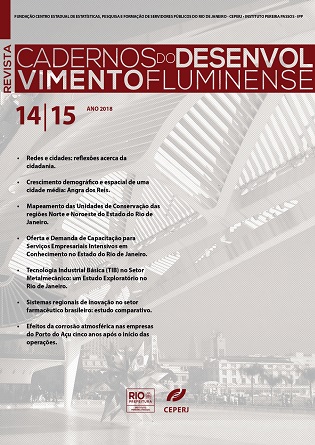Mapping of Conservation Units in the North and Northwest Regions of Rio de Janeiro State, Brazil
DOI:
https://doi.org/10.12957/cdf.2018.47675Abstract
The aim of this work was to evaluate the current scenario of the Protected areas (PAs) of Brazil, focusing on the mesoregion North and Northwest of Rio de Janeiro state. The research was conducted from data provided by the Ministério do Meio Ambiente, like distribution of PAs in the territory, processed by Geographic Information System, information on its area, date of creation, typologies and management. The revenue obtained from the ecological tax was analyzed on the CEPERJ website. The first PA created in this mesoregion was Desengano State Park in 1970. Since the 1990s there have been significant increases in PAs and there are currently 40, 27 of which are Sustainable Use, represented mainly by the Private Natural Heritage Reserve category. In the Integral Protection category, parks make up most of the PAs. The Northwest Region has 4% of its total area protected by PAs, while in the North Fluminense Region this percentage is 6%. The presence of PAs has helped the municipalities of the North and Northwest regions in the capture of ecological tax, totaling about $ 86 million since 2009, which is little representative compared to other municipalities in the state. The Atlantic Forest present in these territories is diverse, with different typologies, where inhabit species under threat of extinction. The expansion of the quantity and good management of existing PAs are means to increase the tax collection of the municipalities and reduce the regional environmental fragility, the result of a disorderly occupation of the territory. PAs can provide essential environmental services such as drought reduction, flooding and soil erosion, recurrent environmental problems in this mesoregion.Downloads
Downloads
Published
How to Cite
Issue
Section
License
Os Direitos Autorais dos artigos publicados na revista Cadernos do Desenvolvimento Fluminense pertencem ao(s) seu(s) respectivo(s) autor(es), com os direitos de primeira publicação cedidos à Cadernos do Desenvolvimento Fluminense, com o trabalho simultaneamente licenciado sob uma Licença Creative Commons Atribuição, a qual permite o compartilhamento do trabalho com reconhecimento da autoria e publicação inicial nesta revista.
O(s) autor(es) tem/têm autorização para assumir contratos adicionais separadamente, para distribuição não-exclusiva da versão do trabalho publicada nesta revista (ex.: publicar em repositório institucional ou como capítulo de livro), com reconhecimento de autoria e publicação inicial nesta revista.
Autores têm permissão e são estimulados a publicar e distribuir seu trabalho online (ex.: em repositórios institucionais ou na sua página pessoal) a qualquer ponto antes ou durante o processo editorial, já que isso pode gerar alterações produtivas, bem como aumentar o impacto e a citação do trabalho publicado.

A revista Cadernos do Desenvolvimento Fluminense está licenciada com uma Licença Creative Commons Atribuição 4.0 Internacional.








